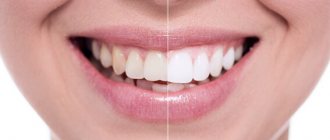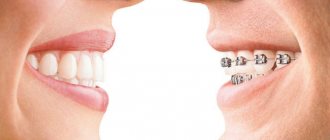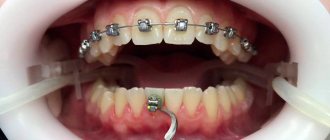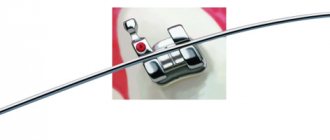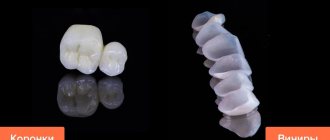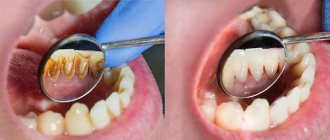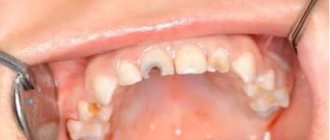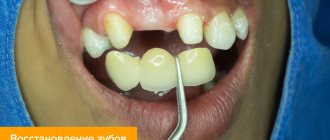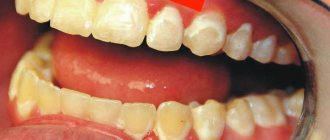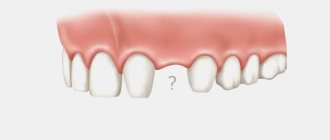Types of veneers
Depending on how veneers differ (material of manufacture or method of installation), they are divided into different types.
Based on the material used, veneers are divided into:
- composite,
- ceramic.
Composite is the fastest and most cost-effective option. Externally, they are inferior to ceramic ones, although they look good. The advantages are affordable price and quick installation. Composite onlays can be made almost immediately, at an appointment with a dentist. To do this, photo-curing resin with ceramic particles is applied to the teeth in layers. Componers look better - overlays created in the laboratory from a special composite material. However, even in this case, the products are less durable and quickly change color under the influence of food and drinks.
Ceramic ones are always made from impressions in the laboratory. Natural appearance, resistance to staining and longer service life - this is what distinguishes ceramic veneers from composite ones. Depending on the manufacturing technology there may be:
- from medical porcelain,
- pressed ceramics
- ceramics with zirconium dioxide.
Porcelain has high aesthetic values. Pressing technology makes the ceramics both thinner and more durable. And the combination of porcelain and zirconium dioxide gives the plates special reliability and external naturalness. The thickness of the ceramic linings is from 0.3 to 0.5 mm.
According to the installation method, veneers can be:
- requiring turning,
- not requiring turning.
Those that do not require turning include lumineers, which are manufactured in the USA and are thin - 0.2 mm. Despite the obvious advantage of preserving enamel, they are not always the best option, and not only because of the high price.
How are microprostheses made?
Making veneers is a complex task that requires high professionalism from the doctor who performs the procedure. After all, it is necessary to carefully evaluate the teeth, prepare them correctly, and obtain measurements for making the veneers themselves. Ceramic dentures at the manufacturing stages are also very fragile, which is why they must be handled carefully.
There are two main ways to make veneers to make your teeth look beautiful.
- The method is used when working with unpressed ceramics. The porcelain mass is applied in layers and gradually fired until the required shape with the desired properties is obtained.
- Overlays made of ceramic pressed material are made slightly differently. They are exposed to an injection press, which allows the prostheses to be given the desired shape using temperature and pressure.
If we are talking about zirconium dioxide dental veneers, they are made using a special automated device. With its help, it is possible, by setting the necessary parameters, to obtain full-fledged prostheses in a short time.
Reasonable prices for services
Highly qualified specialists
Modern techniques and equipment
Treatment on credit and in installments
Dental veneers: pros and cons
For those who have noticeable dental defects, there are many advantages to installing veneers. This will help solve the following problems:
- The presence of spaces between the incisors,
- Chips on the tooth surface,
- Unevenly growing teeth (if the unevenness is not too pronounced),
- Insufficient tooth length or irregular shape,
- Damaged or thinned enamel
- Increased abrasion of enamel,
- Darkened or “spotty” enamel.
By removing a thin layer from the surface of the tooth and attaching an ideally shaped onlay, external imperfections such as shape or uneven placement disappear. Veneering also helps those who have problems with the color of their enamel. This does not mean plaque, which can be eliminated with ultrasonic cleaning or professional whitening, but a radical change in color as a result of taking medications or disruptions in the body. Particularly severe darkening can be due to injury, long-term use of medications (for example, tetracycline antibiotics), or excessive fluoride intake, but there are many other causes. If an unusual change in color has affected not just one incisor, but the entire dentition, it is worth comparing this with the general well-being of the body. If the condition of the teeth cannot be changed by gentle means - enhanced care, changes in diet or therapeutic replacement of drugs, then an alternative may be to replace part of the defective natural enamel with artificial one.
Some suffer from increased tooth abrasion, which, if unimpeded, can lead not only to the destruction of enamel and dentin, but also to hearing impairment, as well as changes in the structure of the face due to displacements in the temporomandibular joint. Abrasion can occur due to many reasons: malocclusion, the presence of systemic diseases, etc. Veneering can become an alternative for such patients, protecting their teeth from further destruction. Therefore, the installation of veneers often has advantages not only in terms of appearance, but also in preserving the functionality of the dentition and the health of the patient in general.
Of course, you can’t do without some inconvenience. The disadvantages include the following factors:
- The need to grind off the top layer of enamel,
- Limited (albeit long) validity period - from 10 to 16 years,
- Possibility of gum recession (displacement of the edge exposing the neck of the tooth),
- The need to handle the pads with care, which includes setting some dietary rules (nothing solid and no sudden changes in temperature).
The main disadvantage of installing veneers is the need to prepare the tooth surface. Even though the onlays are quite thin (0.3–0.5 mm), you still need to make room for them so as not to create the effect of bulging teeth.
Freeing up space is not the only reason - you need to make the surface smooth enough for the onlays to fit perfectly, as well as clean and disinfect it so that there is not a single area left affected by caries.
Grinding is an irreversible procedure; after it, the teeth will always have to be protected with veneers, and if one of the plates breaks, then a replacement must be made as quickly as possible.
In addition, the shelf life of the pads is limited, so after 10–16 years they still need to be replaced.
Gum recession can be caused by various factors: poor manufacturing, installation, or nuances in the operation of the plate. If the thickness of the veneer is too large, or the tightness of the seal is not high enough, then inflammation may soon form and the gums will begin to “retract.” This can be avoided if veneering is carried out in a clinic with modern equipment and specialists competent in this field. However, poor hygiene or using a toothbrush that is too hard can also lead to gum problems.
A safe alternative is lumineers - especially thin products (0.2 mm) that do not require turning to fit. But they have their drawbacks:
- Price and time - they are more expensive than conventional overlays, and are not made in Russia, although impressions and modeling are made individually, after which the data is sent to the production site. Therefore, you will have to wait not 1-2 weeks, but about 1.5 months.
- Color - with the possibility of matching the color to the rest of the teeth, the situation is more complicated. To achieve a natural look, you may need to place not 4 teeth (as with conventional veneers), but 6-8 units.
- Slight thickening - despite the thinness of the products on large teeth, the increase in volume may be slightly noticeable.
- The need for very careful care - unlike veneers, which are placed in a specially prepared “bed,” lumineers allow a gap between the plate and the gum in the root area. Thus, a “convenient” place for bacteria and plaque to accumulate, which can lead to caries or the already mentioned gum recession.
Conclusion: high-quality lumineers are expensive and their production time is longer, but the safety of teeth and comfort in the oral cavity are worth the investment. The main thing is not to run into a fake and not fall into the hands of an incompetent specialist.
After installing the veneer, compliance with dietary rules may also seem like a minus You will have to exclude solid foods and foods that cause tooth wear from your diet. Even carrots and apples will need to be cut into small slices to reduce the stress on teeth with veneers.
Care and service life
There is nothing complicated about caring for ceramic veneers. The basic rule is simple: follow the same recommendations as when caring for your natural teeth. To increase the service life of veneers, it is recommended:
- consume less products with dyes, which can leave pigment on the teeth;
- use a mouthguard while sleeping if you have bruxism, if the installation of veneers occurred contrary to contraindications;
- ensure that the teeth do not receive high loads;
- Visit your dentist regularly so that he can evaluate your upper and lower teeth and can make adjustments if necessary.
The lifespan of standard veneers largely depends on how they are cared for. Usually, if the recommendations are followed perfectly, it is 10-12 years. Lumineers have a longer lifespan; they will last up to 20 years on the teeth.
Like any product, microprostheses tend to break due to stress, lose their shape, and become damaged. This is normal and will not affect the condition of your own teeth if you contact your dentist in time for correction.
General course of treatment
Consultation and diagnosis
Drawing up a treatment plan
Treatment procedure
Preventive examination
When you can’t get veneers
Patients often ask whether it is possible to install a veneer instead of a crown if there is severe tooth decay. This solution is impractical, since the veneer is attached to the enamel. Although the tooth is subjected to preparation, a layer of enamel must still remain - the plate adheres to it, and not to the dentin. Obstacles to installing veneers may include:
- Bruxism (involuntary grinding of teeth),
- High degree of enamel abrasion,
- Significant degree of caries damage and gum inflammation,
- Malocclusion or missing side teeth
- Sealed surface
- Tooth decay.
In any case, a final conclusion requires examination and consultation with a specialist. It all depends on the degree of a particular pathology. Inflammation of the gums and caries are pre-treated, and the preparation of teeth before installation involves cleaning and sanitation. For nighttime teeth grinding, suitable mouth guards may be recommended. The abrasion of the enamel is successfully interrupted by veneering in the initial stage, but if there is little left of the enamel, the doctor will suggest installing a crown.
If some teeth are missing and there is a malocclusion, the situation should first be assessed by an orthodontist - perhaps he will offer a solution to the problem. If a tooth is damaged, you can install a crown - for the veneer to attach to the artificially restored surface and it will not provide adequate protection in this case. The crown will restore the appearance and reliably protect the tooth from harmful influences and further destruction.
Indications for making veneers
Typically, veneers are used to correct the shape and color of teeth. Therefore, the following cases may be indications for installing dental veneers:
- So-called tetracycline teeth (teeth with a pronounced yellow tint).
- Depulpated teeth that have changed color due to a violation of the root canal filling technology (pinkish coloring is possible after filling the canals with resorcinol-formalin paste, yellow - after filling with iodoform-containing paste). Also, tooth discoloration may be associated with injury or amelogenesis imperfecta (a congenital hereditary defect in the formation of tooth enamel).
- Congenital dental defects (so-called hypoplasia).
- Fluorosis, “speckled teeth,” is a disease that develops before teething due to an excess of fluoride compounds in water or food.
- Moderate to severe enamel erosion (for example, erosion of half of the vestibular surface of the tooth).
- Wedge-shaped defects with extensive damage to hard tissues.
- Pathological abrasion of hard tissues.
- Class III carious cavities, when enamel defects are localized on the medial and lateral surfaces of the teeth and cover large areas.
- Demineralization of enamel due to orthodontic treatment after removal of braces.
- Crowded position of the upper central incisors, anomaly in the shape of the teeth, rotation of the tooth along the axis.
- Correction of diastemas and trema.
How to install ceramic veneers
You should carefully consider the choice: whether to install conventional veneers with grinding or lumineers without it. In favor of ceramic veneers, it should be said that due to their ability to transmit sunlight, they look most natural on the teeth and, if fitted well, fit better, leaving no gaps for the accumulation of bacterial plaque.
The installation of ceramic veneers occurs in several stages:
- Color selection
- Taking digital impressions and modeling in the program,
- Grinding of teeth and installation of temporary onlays,
- Taking control impressions and transferring them to the laboratory,
- Production of veneers,
- Installation of permanent overlays.
It may take 1-2 weeks from color selection to the final stage, but the doctor does not leave the patient without protection during this time - he is given temporary plastic overlays, which give the ground teeth a full-fledged appearance and protect them from external influences.
The installation begins with the dentist determining the shade of the future overlays using a special color scale. Then he takes digital impressions, models the veneers in the program and shows the patient the result on the computer screen. Thus, the doctor and patient can agree in advance on the appearance of future products. The client can reconsider whether to get veneers and get answers to his questions.
The next step is turning the enamel. There are several processing methods:
- laser,
- ultrasonic,
- chemical,
- tunnel,
- air-abrasive.
The laser method is fast, silent and painless. In addition, laser treatment simultaneously performs a disinfecting function. This is the optimal method, provided that the preparation is performed by an experienced doctor, and the tooth is not deeply affected by caries. If the caries has gone deeper, you will have to use more intensive methods to eliminate it.
Ultrasound treatment is the most gentle, and therefore does not even require pain relief. The anesthetic is used only in patients with very sensitive teeth.
The chemical is produced with acids; this treatment allows you to very carefully remove the desired layer of enamel. As well as preparation using an air-abrasive mixture.
Tunnel turning is the crudest procedure of these, although it is often used. It involves grinding down the enamel with a drill with a diamond tip, under the influence of which the tooth tissues are heated, which is why the patient is given anesthesia before starting work.
After grinding, temporary veneers are installed. Even if the permanent ones are made in less than a week, it is still worth wearing the removable pads for a couple of weeks to adapt. Permanent veneers are also not immediately glued “tightly”. First, they are attached to temporary glue so that the patient evaluates the result and reports his feelings. Only then is the final installation carried out.
What to choose?
This ensures the strength and durability of the aesthetic plate, prevents pathogenic bacteria from entering the tooth surface and the development of the carious process. When installing a veneer, the most important step is processing the joints between the veneer and the natural tooth, which is carried out using polishing tools, silicone heads, and in some cases even a fine-grained bur.
Is it possible to put veneers on filled teeth? Veneers are installed over fillings if the color does not match the color of your teeth, which creates difficulties during whitening. But there is some problem - the filling material may be less durable than the veneer material, so the tooth under the aesthetic overlays begins to deteriorate over time.
In such cases, composite fillings are removed and a veneer of a more complex shape is made, which partially acts as a filling. Most often, veneers are installed on living teeth with no more than 1 mm of grinding.
Teeth with nerves removed during treatment are fragile and may darken, and veneers in this case not only perform an aesthetic function, evening out the color of their surface, but also prevent chips and cracks in the enamel. Uneven coloring or darkening A small percentage of negative reviews are most often associated with composite veneers.
The main complaint is that composite veneers darken and stain very quickly when exposed to coffee, nicotine, tea, red berries and brightly colored carbonated drinks. At the same time, the color change does not always occur in parallel with the coloring of natural enamel, which makes the veneer stand out and unnatural from the rest.
Patients with veneers on the front teeth can safely drink coffee, eat cherries, currants, raspberries, without worrying about their condition - ceramic plates practically do not stain and can retain their aesthetic appeal for several decades. In the absence of significant loads on the plates, which can occur with bruxism, the absence of one or more chewing teeth, or malocclusion, the plates last for quite a long time - from 3 to 10 years.
Hence the answer to the question, which veneers are best to put on the front teeth. Ceramic plates win in most respects.
Veneer care
Veneers are cared for in the same way as other teeth: brushed and flossed. With the latter you should be careful not to damage either the plates or the gums. No special tools are needed, except for an irrigator - a device that releases a stream of water to rinse the interdental spaces, which can become an alternative to dental floss.
However, there are some rules of conduct after veneering:
- To prevent inflammation of the gums - do not neglect hygiene, do not scratch them with a hard brush (use a soft one).
- Do not clean the plates with an electric brush.
- Do not use whitening toothpastes (ceramic plates remain white anyway).
- Do not eat too hot or cold food.
- Do not bite food with your repaired teeth - you will have to get used to cutting all food into small pieces. Veneers are not designed to be bitten off.
You need to brush your teeth or at least rinse your mouth after every meal. It is advisable to have your teeth professionally cleaned by your dentist periodically.
Who is contraindicated for installing veneers?
There are very few contraindications for microprosthetics using veneers, and most of them are temporary.
Absolute contraindications for installing veneers:
- a significant (half or more) part of the hard tissues of the tooth crown is missing;
- the tooth is pulpless;
- lack of chewing teeth;
- some malocclusions.
Bruxism is also a relative contraindication. But in this situation, after installing the veneers, you can wear a special protective mouthguard while you sleep.
Microprosthetics is not carried out until problems such as:
- caries;
- inflammatory and other pathologies of periodontal tissues;
- the patient’s young age, when the complete formation of the tooth crown has not yet completed.
In addition, installing veneers is not recommended if you do not want to give up some bad habits, such as smoking, or for people involved in extreme or strength sports.
